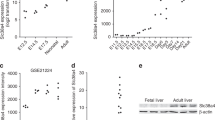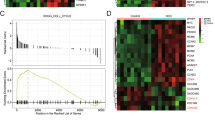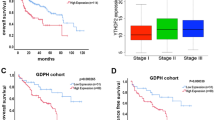Abstract
Oncogenic activation of the WNT/β-catenin signaling pathway is common in hepatocellular carcinoma (HCC). Dishevelled (Dvl), a key activator of the pathway, inhibits the adenomatous polyposis coli complex, and this leads to the accumulation of β-catenin and promotes tumorigenesis. Recently, a novel inhibitor of Dishevelled, namely Dapper (Dpr), was isolated in Xenopus. To explore whether HDPR1, the human homologue of Dpr, has an anti-oncogenic role in hepatocarcinogenesis, we studied the expression of this gene in HCCs. We found that there were two alternatively spliced transcripts of HDPR1, designated as α and β forms, in human liver. Downregulation of the gene expression was observed in 31 (43%) of the 72 human HCC samples using the primer pair that amplified both transcripts. Furthermore, the HDPR1α was downregulated in 42 (58%) of 72 human HCCs and the downregulation significantly correlated with accumulation of β-catenin. Also, downregulation of HDPR1 by RNA interference in HLE cells led to cytoplasmic accumulation of β-catenin. Furthermore, a CpG island located at the promoter region and exon 1 of the HDPR1 gene was methylated in 22 (51%) of human HCCs. We showed that downregulation of HDPR1, in hepatoma cell lines, was associated with methylation of this CpG island using bisulfite sequencing and 5-aza-2′-deoxycytidine demethylation experiment. In addition to methylation-mediated downregulation of HDPR1, allelic loss (13–28% of informative cases) was detected using microsatellite markers flanking the HDPR1 locus. To conclude, downregulation of HDPR1 is common in HCCs, frequently involves hypermethylation of the promoter region, and allelic loss of the HDPR1 locus may also play a role.
This is a preview of subscription content, access via your institution
Access options
Subscribe to this journal
Receive 50 print issues and online access
$259.00 per year
only $5.18 per issue
Buy this article
- Purchase on Springer Link
- Instant access to full article PDF
Prices may be subject to local taxes which are calculated during checkout






Similar content being viewed by others
References
Chan CF, Yau TO, Jin DY, Wong CM, Fan ST and Ng IO . (2004). Clin. Cancer Res., 10, 4140–4149.
Chan TA, Wang Z, Dang LH, Vogelstein B and Kinzler KW . (2002). Proc. Natl. Acad. Sci. USA, 99, 8265–8270.
Cheyette BN, Waxman JS, Miller JR, Takemaru K, Sheldahl LC, Khlebtsova N, Fox EP, Earnest T and Moon RT . (2002). Dev. Cell, 2, 449–461.
Clark SJ, Harrison J, Paul CL and Frommer M . (1994). Nucleic Acids Res., 22, 2990–2997.
Eferl R, Ricci R, Kenner L, Zenz R, David JP, Rath M and Wagner EF . (2003). Cell, 112, 181–192.
Giles RH, van Es JH and Clevers H . (2003). Biochim. Biophys. Acta, 1653, 1–24.
He TC, Sparks AB, Rago C, Hermeking H, Zawel L, da Costa LT, Morin PJ, Vogelstein B and Kinzler KW . (1998). Science, 281, 1509–1512.
de La Coste A, Romagnolo B, Billuart P, Renard CA, Buendia MA, Soubrane O, Fabre M, Chelly J, Beldjord C, Kahn A and Perret C . (1998). Proc. Natl. Acad. Sci. USA, 95, 8847–8851.
Katoh M and Katoh M . (2003). Int J Oncol., 22, 907–913.
Llovet JM, Burroughs A and Bruix J . (2003). Lancet, 362, 1907–1917.
Miyoshi Y, Iwao K, Nagasawa Y, Aihara T, Sasaki Y, Imaoka S, Murata M, Shimano T and Nakamura Y . (1998). Cancer Res., 58, 2524–2527.
Munemitsu S, Albert I, Souza B, Rubinfeld B and Polakis P . (1995). Proc. Natl. Acad. Sci. USA, 92, 3046–3050.
Okazaki I, Wada N, Nakano M, Saito A, Takasaki K, Doi M, Kameyama K, Otani Y, Kubochi K, Niioka M, Watanabe T and Maruyama K . (1997). Hepatology, 25, 580–584.
Pang R, Yuen J, Yuen MF, Lai CL, Lee TK, Man K, Poon RT, Fan ST, Wong CM, Ng IO, Kwong YL and Tse E . (2004). Oncogene, 23, 4182–4186.
Polakis P . (2000). Genes Dev., 14, 1837–1851.
Prange W, Breuhahn K, Fischer F, Zilkens C, Pietsch T, Petmecky K, Eilers R, Dienes HP and Schirmacher P . (2003). J. Pathol., 201, 250–259.
Ryo A, Liou YC, Lu KP and Wulf G . (2003). J. Cell Sci., 116, 773–783.
Satoh S, Daigo Y, Furukawa Y, Kato T, Miwa N, Nishiwaki T, Kawasoe T, Ishiguro H, Fujita M, Tokino T, Sasaki Y, Imaoka S, Murata M, Shimano T, Yamaoka Y and Nakamura Y . (2000). Nat. Genet., 24, 245–250.
Schwabe RF, Bradham CA, Uehara T, Hatano E, Bennett BL, Schoonhoven R and Brenner DA . (2003). Hepatology, 37, 824–832.
Shtutman M, Zhurinsky J, Simcha I, Albanese C, D'Amico M, Pestell R and Ben-Ze’ev A . (1999). Proc. Natl. Acad. Sci. USA, 96, 5522–5527.
Su Q, Liu YF, Zhang JF, Zhang SX, Li DF and Yang JJ . (1994). Hepatology, 20, 788–799.
Sugioka Y, Watanabe T, Inagaki Y, Kushida M, Niioka M, Endo H, Higashiyama R and Okazaki I . (2004). Int. J. Cancer, 109, 867–874.
Tetsu O and McCormick F . (1999). Nature, 398, 422–426.
Taniguchi K, Roberts LR, Aderca IN, Dong X, Qian C, Murphy LM, Nagorney DM, Burgart LJ, Roche PC, Smith DI, Ross JA and Liu W . (2002). Oncogene, 21, 4863–4871.
Theise ND, Park YN and Kojiro M . (2002). Clin. Liver Dis., 6, 497–512.
Uematsu K, He B, You L, Xu Z, McCormick F and Jablons DM . (2003a). Oncogene, 22, 7218–7221.
Uematsu K, Kanazawa S, You L, He B, Xu Z, Li K, Peterlin BM, McCormick F and Jablons DM . (2003b). Cancer Res., 63, 4547–4551.
Wei Y, Van Nhieu JT, Prigent S, Srivatanakul P, Tiollais P and Buendia MA . (2002). Hepatology, 36, 692–701.
Wong CM, Fan ST and Ng IO . (2001). Cancer, 92, 136–145.
Wong HC, Bourdelas A, Krauss A, Lee HJ, Shao Y, Wu D, Mlodzik M, Shi DL and Zheng J . (2003). Mol. Cell, 12, 1251–1260.
Wulf GM, Ryo A, Wulf GG, Lee SW, Niu T, Petkova V and Lu KP . (2001). EMBO J., 20, 3459–3472.
Acknowledgements
This work was supported by a grant (to TOY) from the University Research Committee at The University of Hong Kong.
Author information
Authors and Affiliations
Corresponding author
Rights and permissions
About this article
Cite this article
Yau, TO., Chan, CY., Chan, KL. et al. HDPR1, a novel inhibitor of the WNT/β-catenin signaling, is frequently downregulated in hepatocellular carcinoma: involvement of methylation-mediated gene silencing. Oncogene 24, 1607–1614 (2005). https://doi.org/10.1038/sj.onc.1208340
Received:
Revised:
Accepted:
Published:
Issue Date:
DOI: https://doi.org/10.1038/sj.onc.1208340
Keywords
This article is cited by
-
Upregulation of DACT2 suppresses proliferation and enhances apoptosis of glioma cell via inactivation of YAP signaling pathway
Cell Death & Disease (2017)
-
DACT1 Overexpression in type I ovarian cancer inhibits malignant expansion and cis-platinum resistance by modulating canonical Wnt signalling and autophagy
Scientific Reports (2017)
-
Prognostic significance of the methylation of Wnt pathway antagonists—CXXC4, DACT2, and the inhibitors of sonic hedgehog signaling—ZIC1, ZIC4, and HHIP in head and neck squamous cell carcinomas
Clinical Oral Investigations (2017)
-
Characterization of Hepatocellular Carcinoma Related Genes and Metabolites in Human Nonalcoholic Fatty Liver Disease
Digestive Diseases and Sciences (2014)
-
Reduced expression of DACT2 promotes hepatocellular carcinoma progression: involvement of methylation-mediated gene silencing
World Journal of Surgical Oncology (2013)



